
Cucumber is a widely-cultivated creeping vine plant in the Cucurbitaceae family that bears usually cylindrical fruits, which are used as vegetables. Considered an annual plant, there are three main varieties of cucumber — slicing, pickling, and burpless/seedless — within which several cultivars have been created. The cucumber originates from South Asia, but now grows on most continents, as many different types of cucumber are traded on the global market. In North America, the term wild cucumber refers to plants in the genera Echinocystis and Marah, though the two are not closely related.
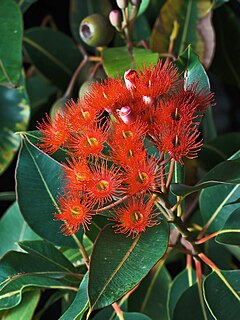
Corymbia ficifolia (syn. Eucalyptus ficifolia, commonly known as the red flowering gum, is a species of small tree that is endemic to the south-west of Western Australia. It has rough, fibrous bark on the trunk and branches, egg-shaped to broadly lance-shape adult leaves, flower buds in groups of seven, bright red, pink or orange flowers and urn-shaped fruit. It has a restricted distribution in the wild but is one of the most commonly planted ornamental eucalypts.

Cucumis anguria, commonly known as maroon cucumber, West Indian gherkin, maxixe, burr gherkin,cackrey, and West Indian gourd, is a vine that is indigenous to Africa, but has become naturalized in the New World, and is cultivated in many places. It is similar and related to the common cucumber (C. sativus) and its cultivars are known as gherkins.

Eucalyptus coolabah, commonly known as coolibah or coolabah, is a species of tree and is found in eastern inland Australia. It has rough bark on part or all of the trunk, smooth powdery cream to pink bark above, lance-shaped to curved adult leaves, flower buds in groups of seven and hemispherical or conical fruit.

Pandorea jasminoides, also known by the common names bower of beauty and bower vine, is a species of flowering plant in the family Bignoniaceae and is endemic to eastern Australia. It is a woody climber with pinnate leaves that have three to nine egg-shaped leaflets, and white or pink trumpet-shaped flowers that are red and hairy inside. It is also grown as an ornamental.

Murraya paniculata, commonly known as orange jasmine, orange jessamine, china box or mock orange, is a species of shrub or small tree in the family Rutaceae and is native to South Asia, Southeast Asia and Australia. It has smooth bark, pinnate leaves with up to seven egg-shaped to elliptical leaflets, fragrant white or cream-coloured flowers and oval, orange-red berries containing hairy seeds.
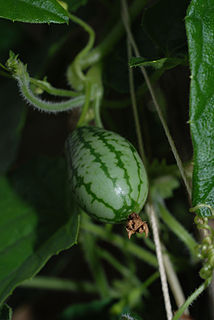
Melothria scabra, commonly known as the cucamelon, Mexican miniature watermelon, Mexican sour cucumber, Mexican sour gherkin, mouse melon, or pepquinos, is a species of flowering plant in the cucurbit family grown for its edible fruit. Its native range spans Mexico to Venezuela. Fruits are about the size of grapes and taste like cucumbers with a tinge of sourness. It has been eaten by indigenous peoples since before Western colonization of the Americas began.

Cardiospermum halicacabum, known as the lesser balloon vine, balloon plant or love in a puff, is a climbing plant widely distributed across tropical and subtropical areas of Africa, Australia, and North America that is often found as a weed along roads and rivers.

Pararistolochia praevenosa is an Australian vine in the birthwort family. The Richmond birdwing butterfly vine grows in subtropical rainforest in coastal areas north from Wollongbar, in far north eastern New South Wales and adjacent areas in south eastern Queensland. It has been recorded as far north as the Mary River. It also grows in tropical north eastern Queensland, where it is a food plant for the Cairns birdwing butterfly.

Pseudoweinmannia lachnocarpa is a rainforest tree of eastern Australia. Common names include rose marara, mararie, scrub rosewood and red carabeen. The species name lachnocarpa is from the Greek, referring to the "woolly fruit". The genus name refers to the similarity of another genus, Weinmannia, after the German eighteenth century pharmacist J.W. Weinmann.
Zehneria baueriana, commonly known as the native cucumber or giant cucumber, is a species of flowering plant – a vine in the cucumber and gourd family, Cucurbitaceae. It is found on Norfolk Island, an Australian territory in the Tasman Sea, as well as in New Caledonia. The specific epithet honours Austrian botanical illustrator Ferdinand Bauer who collected on Norfolk Island in 1804 and 1805.
Tylophora barbata, the Bearded Tylophora, is a small vine in the dogbane family. A common plant found south of Bulahdelah, New South Wales. The habitat is rainforest and moist eucalyptus forests in south eastern Australia. Not often seen in flower, but flowers are dark red, around 7 mm long on thin stalks. Broken branches produce watery or milky sap.
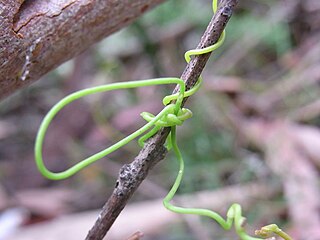
Cassytha glabella, commonly known as the slender devil's twine, is a common twining plant of the Laurel family, found in many of the moister parts of Australia. A hemi-parasitic climber. The specific epithet glabella is from Latin, referring to the lack of hairs. The fruit are sweet and mucousy to taste. The Devil's Twine and Cassytha melantha are similar, but with thicker hairier stems.

Eucalyptus socialis, commonly known as the red mallee, or grey mallee, is a species of mallee that is endemic to inland Australia.

Eucalyptus sessilis, commonly known as Finke River mallee, red bud mallee or river mallee, is a species of mallee that is native to the Northern Territory and central areas along the border of Western Australia. It has smooth bark, sometimes with ribbon of old bark near the base, lance-shaped to egg-shaped or elliptical adult leaves, flower buds in groups of seven, creamy yellow flowers and hemispherical fruit.
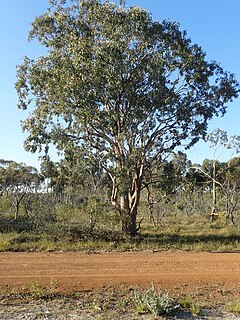
Eucalyptus sheathiana, commonly known as ribbon-barked gum, is a species of tree or a mallee that is endemic to Western Australia. It has smooth bark that is shed in long ribbons, lance-shaped adult leaves, flower buds in groups of seven, creamy white flowers and conical to cup-shaped fruit.

Corymbia eremaea, commonly known as mallee bloodwood, hill bloodwood and centre range bloodwood, is a small, mallee-like tree that is endemic to central Australia. Indigenous Australians know the plant as muur-muurpa. It has rough, evenly tessellated bark, lance-shaped leaves, oval to pear-shaped flower buds arranged on a branching peduncle and urn-shaped fruit.
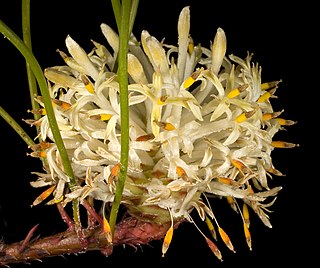
Petrophile prostrata is a species of flowering plant in the family Proteaceae and is endemic to southwestern Western Australia. It is a prostrate shrub with needle-shaped but usually not sharply-pointed leaves and spherical heads of hairy, pale yellow or cream-coloured flowers.
Cucumis ficifolius is a dioecious flowering vine in the family Cucurbitaceae.
Melothria cucumis is a species of flowering plant in the cucurbit family native to Bolivia, Paraguay, Peru, Uruguay, and parts of Argentina and Brazil. It is a herbaceous vine which produces oblong-ovoid green fruits 3–4 cm (1.2–1.6 in) long and 2–2.5 cm (0.8–1.0 in) wide. Plants use tendrils to climb.















